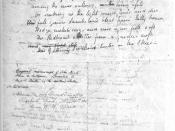Keats wrote 'To Autumn' directly after abandoning 'The Fall of Hyperion', during September of 1819. It is among the last of his poems and it is often regarded as the most achieved of his odes. 'To Autumn' is more abundant than at first glance. It didn't touch me like 'Ode to Psyche', but it left me with an equally pleasant feeling of harmony and purpose. Keats once said about Byron 'He describes what he sees - I describe what I imagine, mine is the hardest task'. 'To Autumn' is certainly evidence of this process. The first stanza though, is building up the landscape in a more concrete way. Its full of excellent picture language like:
And fill all fruits with ripeness to the core,
To swell the gourd, and plump the hazel shells
Then in the second stanza he starts filling an already almost perfect picture with his imagination.
He moves the background from the ripened fruit to the cider press. He personifies Autumn embodies her in the daily labours of harvest-time. The second line in the this stanza: 'sometimes whoever seeks abroad may find' is for me particularly interesting. I can relate to it so much because it holds such optimism and harmony. Actually it seems to me that the entire second stanza (except the last four lines) is heavy with sleepiness. Take for example the following:
Thy hair soft-lifted by the winnowing wind;
Or on a half-reap'd furrow sound asleep,
Drows'd with the fume of poppies while they hook,
Spares the next swath and all its twined flowers:
The four last lines of the second stanza which I spoke of, consists of the realisation of Autumn in physical action. A girl (autumn) walks on a plank across a brook when...



To Autumn
You have written an interesting poetry analysis of John Keats' beloved ode. It's not so much that Keats says anything truly important in his tribute to Autumn, but the way he says it is truly beautiful. I especially like the poem's last stanza in which Keats expresses with sad acceptance the season dying or ending. I have trouble accepting the sad death at only age 26 of a poet whose great potential was only fractionally fulfilled when his life ended too soon.
6 out of 6 people found this comment useful.